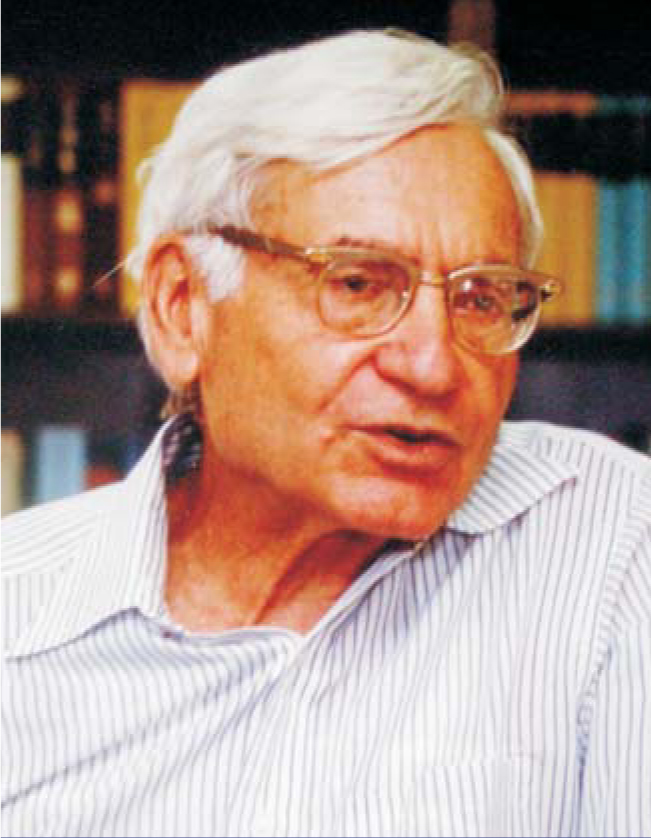Alvin Martin Weinberg
DOI: 10.1063/1.2743138
Reactor physicist Alvin Martin Weinberg died peacefully at home on 18 October 2006. He was a passionate advocate for safe nuclear energy, was actively involved with the issue of global warming before that phrase was coined, and was an effective adviser on science, energy, and technology in Washington, DC, and abroad.
Alvin was born in Chicago on 20 April 1915 and was educated at the University of Chicago, where he received his AB in 1935 and AM in 1936 in physics and his PhD in molecular physics, under Carl Eckart, in 1939. His first paper, “Rotation and Vibration of Linear Triatomic Molecules,” written with Eckart, was published in the Journal of Chemical Physics in 1937. His 541st publication, entitled “New Life for Nuclear Power,” appeared in 2003.
At the University of Chicago, Alvin was studying the physics of nerve conduction with Nicholas Rashevsky in 1941 when the Manhattan Project established the Metallurgical Laboratory there. Because of his considerable mathematical skills, Alvin was co-opted into the atomic bomb project to work with Eugene Wigner on the design of the huge plutonium production reactors for Hanford, Washington. Wigner, who would become Alvin’s hero, was looking for someone with keen physical intuition and a strong record in theoretical physics. Alvin had both.
In 1945 Alvin was transferred to Oak Ridge to design the Clinton Laboratories’ X-pile, the world’s first nuclear reactor, to be a production reactor to make gram quantities of plutonium for use in chemical studies to separate plutonium from uranium. Clinton Laboratories became Oak Ridge National Laboratory and the X-pile became the graphite reactor, later the source of all the radioisotopes that transformed biology and many other sciences after World War II.
Under Alvin’s leadership—he was research director from 1948 to 1955 and director from 1955 to 1973—ORNL changed from a purely nuclear laboratory to a multidisciplinary national laboratory that not only built reactors and accelerators but also developed expertise in environmental research, ecology, metallurgy, mathematics, economics, and fusion. Through his involvement with the details of research programs and their general direction, Alvin was a one-man quality assurance program.
Nuclear power was uppermost in Alvin’s mind throughout his life. He saw nuclear energy as a way to beat the Malthusian curse. With cheap, unlimited energy, he saw the possibility of desalting seawater and making arid parts of the world productive. He envisioned agro-industrial complexes in India that would provide water for agriculture and electricity for industrial development. If high-grade uranium ores became depleted, Alvin was going to “mine the rocks” or “mine the sea”— that is, extract uranium and thorium from granite or from the oceans, where they are present in small quantities.
Alvin was not a blind booster of nuclear power. From the outset he was concerned with reactor safety, and he argued for the creation of the Nuclear Regulatory Commission so that one agency, the Atomic Energy Commission, would not be both the advocate and regulator of nuclear power. His vocal concerns about reactor safety cost him his job at ORNL.
Daunted but not defeated, Alvin established the Institute for Energy Analysis in Oak Ridge in 1975, following a year-long stint as director of the White House Office of Energy Research and Development. With a small group of associates and a wider group of visitors, he delved into the carbon dioxide greenhouse problem, the issues connected with nuclear waste, and environmental and other consequences of energy conversion and use. He was director of the institute until 1985.
A prominent member of the US science establishment, Alvin was a member of both the National Academy of Sciences and the National Academy of Engineering—a rare honor—and was involved in many science-related studies. As a member of the President’s Science Advisory Committee from 1960 to 1962, he represented national laboratories in a body of largely academic and industrial representatives. He is well known for his writing on scientific choice, wherein he distinguishes between intrinsic and extrinsic criteria. Intrinsic criteria have to do with the value of the science itself: Is the science productive? Are good people working in it? Are the results important? Extrinsic criteria deal with the question, Is this particular science affecting other areas of science or the welfare of the people? He argued that more funding should go to the sciences that showed great extrinsic value. For example, he concluded that high-energy physics involves energies and time scales that cannot affect other sciences or the wellbeing of humanity. That position earned him the ire of a large fraction of elementary-particle physicists, but fortunately did not emasculate the budget for that branch of physics. In his later days, when the connection between particle physics and cosmology became more evident, Alvin had begun to change his mind.
Alvin deservedly accrued many honors. He received both the Atoms for Peace Award and the Ernest Orlando Lawrence Award in 1960, the 1980 Enrico Fermi Award, and many others, including my favorite, the Young Man of the Year Award from the US Junior Chamber of Commerce in 1951.
Alvin was a superb laboratory director. He knew everyone on the research staff by name, he knew their work in detail, he listened to their presentations, and from his front-row seat he asked pointed questions. More than a manager, he was a true scientific leader. He will never be replaced.

Alvin Martin Weinberg

More about the Authors
Alexander Zucker. University of Tennessee, Knoxville, US .
